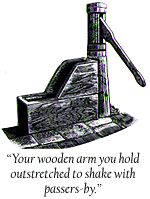Main Menu · Search · Current Issue · Contact · Archives · Centennial · Letters to the Editor · FAQs


![]()
Traditionalists raised a ruckus when the University began to remodel the Harvard Union last year. They were especially vexed by plans to divide its palatial dining hall into two large meeting rooms. That's now a fait accompli, and the building reopens this spring as the headquarters of a new humanities center. A preview in the Harvard Crimson reports that "each room preserves much of the feel of the old Union," retaining the former dining hall's carved paneling and large fireplaces.
That's reassuring, but the proprietor of this column is vexed by the Crimson's way of referring to the Union building as "the new Barker Center for the Humanities."
That usage may become general, but it shouldn't. The fact is that the Barker Center--so named because it is funded in part by a $13 million gift from Robert R. Barker '36--resettles a dozen far-flung academic departments in a complex made up of the Union and two neighboring buildings, Burr Hall (the former Varsity Club) and Warren House. Respect for the donors, and those memorialized therein, requires that the buildings' names be retained.
Designed by the celebrated New York firm of McKim, Mead, and White, the Union was given to Harvard at the turn of the century by Henry Lee Higginson, then a member of the Corporation. Major Higginson, a member of the class of 1855 who left Harvard during his freshman year, was as good a friend as the University ever had. He was twice an Overseer, helped incorporate Radcliffe College, donated the 31-acre tract that became Soldiers Field, and secured the present sites of the Medical School and the Business School. Higginson saw the Union as a "house of fellowship" for the many students who could not or would not join Harvard's elite social clubs. Faculty members and alumni would be welcomed. The building, he suggested, could also be a memorial to the 11 Harvard men who died in the Spanish-American War. He did not want it named for him. At a "ratification meeting" in 1899 he described the Union as "the result of Harvard teamwork, of mutual reliance," and decreed, "therefore let it never and in no place bear any name except that of John Harvard."
*
"Anyone who has the luck to gain money must feel the insolent power of it," Higginson later wrote to a friend. "So a person of any modesty often prefers to hide the name of the giver. I lie about it now and then." In 1911 he wrote an essay titled "Hint to the Rich" for the Atlantic. It began with one of his favorite quotations, a motto from the gravestone of Edward Courtenay, Earl of Devonshire:
*
To close out these reflections on naming things, let's take the subject a bit further--say, 238,857 miles further. How many of us are aware that a blip on the lunar landscape owes its name to an acronym devised for a Harvard building? For this piece of intelligence the Pump is obliged to Tom Lehrer '47, A.M. '47, mathematician, teacher, and comic song writer nonpareil. From his presumably voluminous files, Lehrer has sent an old New York Times clipping stating that the 1972 moon visit of astronauts Eugene Cernan and Harrison Schmitt will include a stop "at a crater named Van Serg, after Prof. Hugh McKinstry, a 20th-century mining geologist who wrote satires under the pseudonym Nicholas Van Serg." To which Lehrer adds,
"Here's my theory:
"Hugh McKinstry (1896-1961) was a professor of geology at Harvard until his death.
"The geology department was near the Vanserg building, and Professor McKinstry must have known the name. (He may even have dined there, as it was for some years the home of the graduate dining hall.)
"As far as I know, there is no such name as Van Serg in any language.
"It is therefore reasonable to assume that he took his pen name from the name of the building, spelling it 'Van Serg' to make it sound more like a surname.
"The Vanserg building is a 'temporary' building, erected at the end of World War II to house various departments. (The roster has changed over the years; it has included the mathematics department and--currently--expository writing and history and literature.) Since the building was meant to be temporary, there was no benefactor after whom to name it, so they used an acronym of the names of the original tenants, namely Veterans Administration, Naval Science, Electronic Research, and Graduate dining hall. (This fact appears to be known only to those who were around at the time.)
"Thus there is a crater on the moon which derives its name from a Harvard acronym. I rest my case."
The Pump is advised by Owen Gingerich, professor of astronomy and the history of science, that the International Astronomical Union lists Van Serg not as a crater but as a "lunar feature named by an Apollo 17 astronaut." And who could that have been? The prime suspect has to be Harrison Schmitt, Ph.D. '64.
~ Primus IV
Main Menu ·
Search · Current Issue · Contact · Archives · Centennial · Letters to the Editor · FAQs
![]()